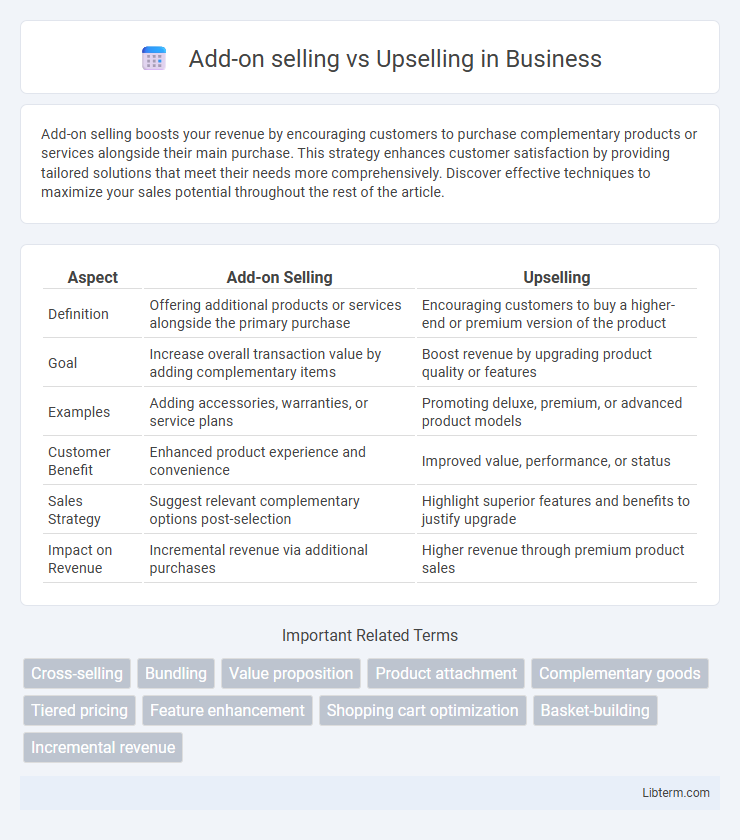Add-on selling boosts your revenue by encouraging customers to purchase complementary products or services alongside their main purchase. This strategy enhances customer satisfaction by providing tailored solutions that meet their needs more comprehensively. Discover effective techniques to maximize your sales potential throughout the rest of the article.
Table of Comparison
| Aspect | Add-on Selling | Upselling |
|---|---|---|
| Definition | Offering additional products or services alongside the primary purchase | Encouraging customers to buy a higher-end or premium version of the product |
| Goal | Increase overall transaction value by adding complementary items | Boost revenue by upgrading product quality or features |
| Examples | Adding accessories, warranties, or service plans | Promoting deluxe, premium, or advanced product models |
| Customer Benefit | Enhanced product experience and convenience | Improved value, performance, or status |
| Sales Strategy | Suggest relevant complementary options post-selection | Highlight superior features and benefits to justify upgrade |
| Impact on Revenue | Incremental revenue via additional purchases | Higher revenue through premium product sales |
Introduction to Add-on Selling and Upselling
Add-on selling involves offering complementary products or services that enhance the primary purchase, increasing the total transaction value by meeting additional customer needs. Upselling focuses on encouraging customers to buy a higher-end version or upgrade of the product they are considering, boosting revenue through premium options. Both strategies optimize sales by tailoring offers to customer preferences and maximizing per-customer revenue potential.
Key Differences Between Add-on Selling and Upselling
Add-on selling involves offering complementary products or services that enhance the primary purchase, while upselling encourages customers to buy a higher-end or more expensive version of the same product. Key differences include the customer's intent, where add-on selling targets additional needs, and upselling focuses on upgrading the existing choice. Metrics like average order value and customer satisfaction rates often differ, with upselling typically driving higher-priced sales and add-on selling improving overall purchase volume.
Psychological Principles Behind Add-on Selling
Add-on selling leverages the psychological principle of commitment and consistency, encouraging customers to enhance their original purchase with complementary products that align with their initial choice. This approach taps into the desire for convenience and completeness, making buyers feel they are making a smart, value-driven decision without abandoning their original intent. Unlike upselling, which pushes for a higher-priced alternative, add-on selling strategically enhances the buyer's satisfaction by offering relevant, smaller enhancements that seem reasonable and easy to justify.
The Art of Effective Upselling
Effective upselling leverages customer insights to recommend higher-value products that align with their needs, enhancing satisfaction and increasing revenue per transaction. Techniques such as personalized suggestions, highlighting premium features, and demonstrating added benefits help create a compelling case for customers to upgrade. Mastering the art of upselling involves balancing persuasive communication with genuine value, ensuring customers perceive the offer as beneficial rather than pushy.
Benefits of Add-on Selling for Businesses
Add-on selling enhances revenue by encouraging customers to purchase complementary products, increasing the average transaction value without pressuring them to buy higher-priced items. This method improves customer satisfaction through tailored recommendations that meet specific needs, fostering loyalty and repeat business. Businesses benefit from streamlined inventory turnover and better utilization of existing stock, reducing storage costs and maximizing profit margins.
Upselling Strategies That Actually Work
Upselling strategies that actually work focus on enhancing the customer experience by offering higher-value products or services tailored to individual preferences, such as personalized recommendations based on previous purchases or browsing behavior. Effective upselling emphasizes clear communication of added benefits, like extended warranties or premium features, which justify the higher price and increase perceived value. Businesses employing data-driven techniques, including AI-powered analytics and customer segmentation, see significant improvements in conversion rates and average order values through targeted upselling efforts.
Common Mistakes in Add-on Selling and Upselling
Common mistakes in add-on selling include offering irrelevant or low-value products that fail to meet customer needs, which can reduce overall satisfaction and trust. In upselling, pushing higher-priced options without clearly communicating benefits often leads to customer resistance and lost sales opportunities. Both strategies suffer when sales teams neglect tailored recommendations based on customer behavior and purchase history, limiting the potential for effective revenue growth.
Impact on Customer Experience and Loyalty
Add-on selling enhances customer experience by providing tailored product options that meet specific needs, increasing perceived value and satisfaction. Upselling encourages customers to consider higher-tier products, potentially improving their overall usage and loyalty by delivering enhanced features or benefits. Both strategies, when executed with customer-centric communication, foster trust and long-term engagement, significantly boosting retention rates.
Integrating Add-on Selling and Upselling into Sales Processes
Integrating add-on selling and upselling into sales processes enhances revenue by offering customers complementary products and higher-value alternatives tailored to their needs. Effective sales strategies leverage data analytics and customer behavior insights to identify optimal moments for presenting add-ons or premium options, increasing average transaction value. Streamlining these techniques within CRM systems ensures consistent execution and personalized recommendations, improving customer satisfaction and long-term loyalty.
Measuring the Success of Your Sales Techniques
Measuring the success of add-on selling involves tracking the average transaction value and frequency of complementary product purchases, whereas upselling is evaluated by the increase in the average order size and the upgrade rate to higher-value products or services. Key performance indicators (KPIs) such as conversion rates, customer retention, and sales growth provide crucial data for analyzing the effectiveness of both sales strategies. Advanced analytics tools and customer feedback further help in refining techniques to boost revenue and enhance customer satisfaction.
Add-on selling Infographic

 libterm.com
libterm.com